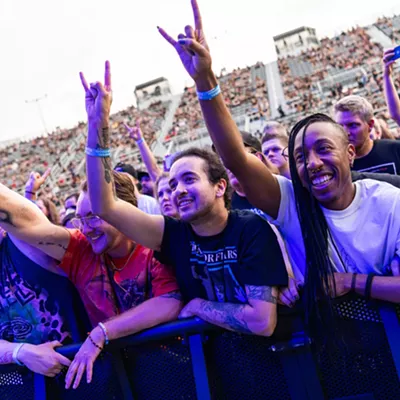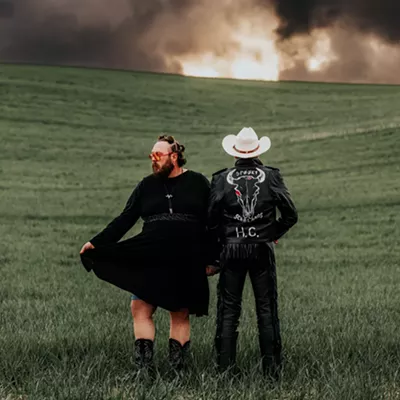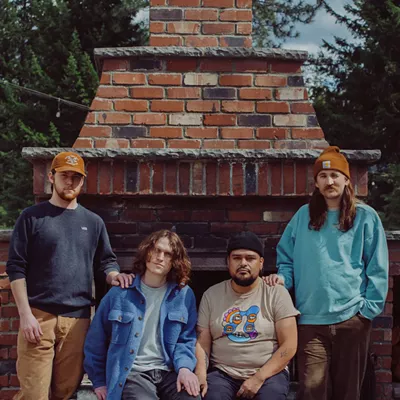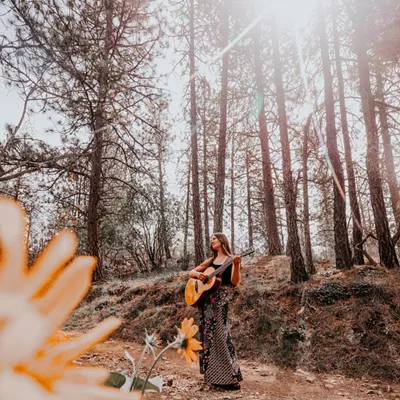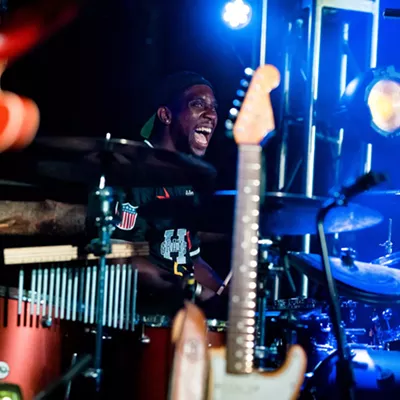So true, in fact, that 'Kan bashing is still one of the easiest ways to make new friends at local shows. Try it some time. Go up to a stranger and ask, "Know what sucks?" Then, just before they offer their answer, say, "The live music scene here, that's what."
The answer will always come back one of two ways. From the cynics, you'll get a dismissive, "Yeah, it does." From the optimists -- a growing minority population in the area -- you'll get a hopeful, "It's getting better, though."
Either way, you've made a new friend.
There's been a perception in our scene as long as I've been covering it that Spokane is a second-tier town. It doesn't have Seattle- or Portland-type musical talent within its borders, and it doesn't draw top-flight touring acts from outside. This was also the perception former Inlander music writer Mike Corrigan saw for most of his decade covering local music.
The Inlander has been covering the scene and its self-perception since Day One and looking back. The game in Spokane has always been a struggle, and that pisses people off. It always has and, it seems, it always will.
Since I started writing for The Inlander, I've decried three specific bands for skipping town -- an Inlander music-writer tradition since 1993. I've begged five specific bands to play here -- another Inlander institution, founded circa 1995. I've reported on the economics and politics of scene-building; The Inlander first began reporting on that frustrating alchemy in 1997.
Much of what we cover day-to-day has been written before. Familiar storylines are reconfigured with new scene faces and pop-culture in-jokes. Bands and clubs and controversies come and go and come again. Still, looking back, we've noticed some trends that speak volumes about where Spokane was, where it is and where it's going.
The Digitizing of Music
Looking through our coverage of late '90s phenomena like Napster and iTunes, Kevin Taylor says the tone was like "taking a look into this bright, shiny future." We expressed doubt in 1997 that the Internet was worth the hype, and then, a year later, we worried that the Y2K bug would be the downfall of civilization as we knew it.
The editorial tone at The Inlander toward digital music, though, was one part gleeful excitement one part anti-RIAA-finger-wagging the whole way through. No doom and gloom there. Sure, there were warning signs that free, abundant music would cripple the record industry, but our relationship with major labels was always strained at best. They were The Man, basically, and we hoped that one day their business model would fall apart, giving way to a kind of communal garage-rock utopia.
Who could have predicted the post-millennial course, though? After eight years of sliding sales, tractionless reboots, dwindling artist development and lawsuit setbacks coupled with the ascendancy of social networking, cheap recording tech, advertisers eager to license the MySpace generation, and the death of selling out, the music landscape is almost unrecognizable. It's no longer the secret wish of every hot young artist to put out an album on Sony or Warner Brothers. It's also no longer a cred-killer to license your best songs to network TV.
We had an epiphany this year, while profiling the area's "Buzzworthy Bands" for our Local Music issue. The titans of the music industry have been at war with themselves for so long that an entire generation of young artists and songwriters has grown up reliant on home-recording and grassroots publicity. Even in Spokane, DIY is no longer counterculture. It's the only culture.
The Secularization of All Ages
In the summer of 1997, a 12-year-old girl went to her first rock show with her brother. A Christian underground show. Back then, for tweens and the underage set, that was one a few options for local shows. "Anything that was all-ages was Christian and supported ... Christianity," recalls Rhea Beumer, now 23. Discovering photography not long after she discovered hard music (and becoming an Inlander contributor in 2006), she's been a fixture in the scene since.
As this little swatch of history went largely unreported-upon anywhere except in the music listings of The Local Planet, oral histories like Beumer's are the best record we have of small, local, all-ages music in the '90s and early 2000s.
Between '97 and 2000 -- what Beumer calls "the early days" -- the local all-ages scene was dominated by churches and house parties. Besides faith-based RAWK, which brought a drug-free all-ages environment to the Big Dipper, the scene was Calvary Chapel, the Underground and LifeCenter. Or it was VFW halls. Or it was your friend's basement. And then usually only once or twice.
Things changed with the millennium. All-ages shows hesitantly secularized. "Caf & eacute; Sole had a lot of the first non-Christian I went to," Beumer says. Gradually places like Rock Coffee and the first incarnation of Empyrean asserted their presence. Once Rock closed, manager Patrick Kendrick set up shop, and two years ago the Blvd began putting on all-ages shows early in the evenings before their 21-and-older shows.
Beumer notes that most of the small shows RAWK used to put on now funnel through Empyrean or through Emmaus Road Collective, a production company that puts on shows around town.
RAWK is still around today, but Dale Strom, one of its principals, notes that the shows it puts on at the Big Dipper aren't doing as well as they once did. "They aren't making money," he says, though, "Our big shows [at the much larger Service Station] do well."
The Shrinking of Club Sizes
That first local music issue had two stories of note on the issue of music venues. The first, an essay called "Clubbed to Death," discussed horrid economics and unfriendly civic politics as reasons for frequent club closures in town. This was a time when bands played the Met, the Arena, and (later) Fat Tuesday's and the Big Easy -- venues that lived and died by the price of admission charged.
Now the politicians are warming up to clubs. (Did you see Mayor Mary Verner pose with all those high schoolers at the RAWK Final Four? Adorable.) Meanwhile, however, the economics have gotten worse. Fewer and fewer pure clubs exist in Spokane. When Fat Tuesday's went down, nothing took its place. When the Met (now the Bing) stopped hosting rock shows as frequently as it did in the late '90s, nothing took its place.
The clubs that have sprung up aren't as big as they used to be. "They're getting smaller in scale," Mike Corrigan notes. "They're being squeezed in wherever there's space. It's cool." The Knitting Factory is the only pure club left in Spokane, a place that opens an hour before its evening show and stays shuttered the rest of the time. It's the only venue with a capacity of more than 500 that regularly hosts music at all.
No, the majority of music is handled today by bars and coffeeshops that can stay afloat despite often pulling only 100 people. It's perhaps an outgrowth of the DIY show scene that Rhea Beumer has been chronicling in film since the late '90s. It's more likely a reflection of the economics. There are more bands than ever, but fewer than ever before of the hugely popular bands.
Though Caf & eacute; Sole was never able to gain a foothold, closing and reopening "like, five times," by Beumer's count, its caf & eacute;-cum-music-venue business model paved the way for mixed-use places like the Blvd, Caterina and Empyrean, all of which book tons of shows in relatively small spaces and supplement their income as venues by slinging booze or coffee or both during shows -- and by providing a place to hang out with friends when not watching shows.
Music has always been a culture. In the last decade, it seems venues have come to reflect that.
The Eternal Recurrence of the Game
Despite the shrinking of club sizes, the bottom falling out of the CD market and the failure of online music sales to make up the slack, the game remains. Despite the dismantling of the major label system and the gradual shrinking of venue sizes, bands are still writing songs, recording them, playing them live, planning tours, selling merch, scrambling, hustling, trying to connect with fans.
The Internet has made that easier for every aspiring artist, but it's also made the routes to success more numerous and less clear. More choice, not surprisingly, means more choices. While the music industry is in shambles, the music business locally is as good as it's ever been.
So while it's no doubt a scary time to be a musician or a club owner or a label head, it's an amazing time to love music.



